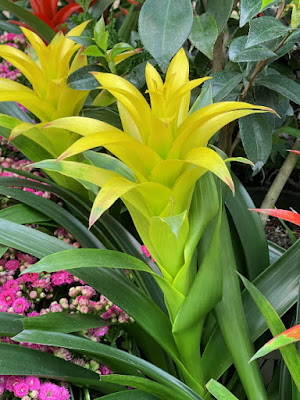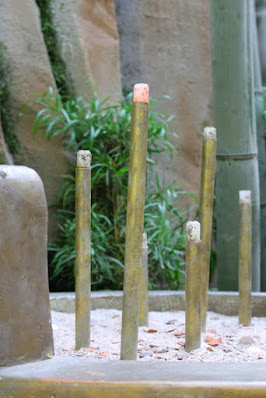 |
| Picture by Kolohe |
The Bellagio Conservatory 2024 Chinese New Year arrangement is titled: "Infinite Prosperity: The Year of the Dragon," which was inspired by The Dragon and the Pearl folklore legend.
According to the legend, a boy found a magical pearl and hid it in bag of rice, which caused the rice to multiply, overflowing the bag. As the bag kept producing rice, the boy was able to feed all of the people of the land. However, upon learning of the magic pearl, the greedy emperor decided he wanted it for his own use. Fearing that the greedy emperor would take the pearl, the boy swallowed it, so the emperor could not find it. After swallowing the pearl, the boy turned into a kind dragon and protected all of the people of the land. In the exhibit, the kind dragons hold symbolic pearls, which some say hold the secrets of the universe.
Entrance to the Conservatory is along a walkway between two red railings flanked by four "kind" dragons, Cherry blossoms, and a tall Chinese pavilion. Each dragon has a foot on a "magical pearl." (In some of the pictures, camera lens parallax distorts the pearls' round shapes.)
The Cherry tree blossoms are a symbol of love, beauty, and renewal. Because the blossoms typically only last for a week or two, they also "represent a time of...optimism while reminding us to appreciate life's fragility and transience."
 |
| Picture by Kolohe |
 |
| Picture by Kolohe |
 |
| Picture by Kolohe |
 |
| Picture by Kolohe |
 |
| Picture by Kolohe |
 |
| Picture by Kolohe |
 |
| Picture by Kolohe |
 |
| Picture by Kolohe |
 |
| Picture by Kolohe |
 |
| Picture by Kolohe |
Caishen, the Chinese God of Wealth, is featured in the North Bed between two money trees. Folklore tells us the that Caishen has "the power to grant blessings for wealth and prosperity in the year ahead." Each money tree contains 88 gold I-Ching coins. The number "8" is a symbolic lucky number in Chinese Culture.
 |
| Picture by Kolohe |
 |
| Picture by Kolohe |
 |
| Picture by Kolohe |
On Caishen's left side is a money tree surrounded by flowers and a boy holding a lucky I-Ching coin in the air for all to see. Similarly, on Caishen's right side is another money tree surrounded by flowers and a boy holding another lucky I-Ching coin.
 |
| Picture by Kolohe |
 |
| Picture by Kolohe |
 |
| Picture by Kolohe |
 |
| Picture by Kolohe |
 |
| Picture by Kolohe |
 |
| Picture by Kolohe |
Located above the exhibit are red silk ornaments that have medallions attached at bottoms to pay homage to the Year of the Dragon.
 |
| Picture by Kolohe |
A large serpentine dragon in the center exhibit is holding a pearl in one claw. Behind the dragon is a waterfall, which is "symbolic of a new cleansing year" and the "showering of riches." (There is a sign by the waterfall stating that 100% of all water used in Bellagio's Conservatory and Botanical Garden comes from captured rain water and recycled resort water.)
 |
| Picture by Kolohe |
 |
| Picture by Kolohe |
 |
| Picture by Kolohe |
Also located in the center exhibit is a replica of the Temple of Six Banyan Trees. The actual Temple was built in AD 537 in Guangzhou, China. For those with enough I-Ching coins, and the desire to have several hundred people watch you eat, dining is available in the Bellagio Temple with food prepared by Noodles Pan-Asian Restaurant.
Surrounding the Temple are various flowers and ding pots filled with incense. Prosperity, the incense name, includes honeysuckle nectar, hyacinth, lemon, and orange. Oranges, kumquats, tangerines and pomelos are important in the Chinese New Year because "they're believed to bring good luck and happiness. The Chinese words for orange and tangerine closely resemble the words for luck and wealth. The gold color also symbolizes prosperity."
Ding pots represent "gratitude for the prior year and home for future good fortune in all facets of life."
 |
| Picture by Kolohe |
 |
| Picture by Kolohe |
 |
| Picture by Kolohe |
Included in the south bed exhibit are two animated lions that perform traditional lion dances and their eyes follow you as you walk by. In real life, a lion dance is performed by two people under the costume. One person acts as the head and the other person as its tail. The lion dance is performed to bring prosperity and good fortune.
 |
| Picture by Kolohe |
Located in the center of the south exhibit is a 46-foot wooden bridge that spans a small pond separating two lions. Arch bridges are important in Chinese tradition because they are the oldest type of wooden bridges in the world and have great natural strength.
Located over the bridge is a 44-foot dragon that is used in the dragon dance. Unlike the lion dance that involves two people, the dragon dance requires a team of people to move the dragon. The leader moves the head while the other team members make the creature "dance" to ward off evil spirits and bring good fortune for the new year.
 |
| Picture by Kolohe |
 |
| Picture by Kolohe |
 |
| Picture by Kolohe |
 |
| Picture by Kolohe |
 |
| Picture by Kolohe |
Overhead are fireworks made from red silk with golden accents. Red is considered good luck and fireworks are used to keep evil spirts away and mark the start of a safe and prosperous new year.
 |
| Picture by Kolohe |
There are guests from around the world that come to the Bellagio Conservatory to have their pictures taken. We visited with a young girl from Guadalajara, Mexico, that was celebrating her quinceanera. Quinceanera is a young girl's 15th birthday celebration, marking her progression from girlhood to womanhood.
There were also some young people staying with us from Idaho and Utah that came to see their grandparents. |
| Picture by Kolohe |
A Fu Dog was located at the front door of the Bellagio Hotel/Casino to ward off negative energy and bring good luck to entering casino guest.
 |
| Picture by Kolohe |
 |
| Picture by Kolohe |


































































No comments:
Post a Comment